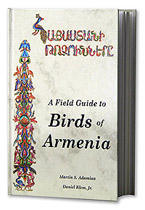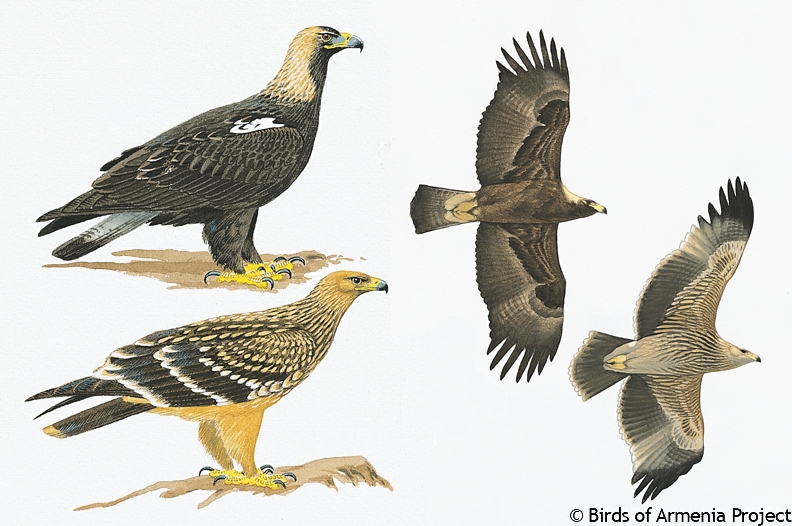- Pictures of All Birds
- Find Bird by Common Name
- Find Bird by Scientific Name
- Find Bird by Armenian Name
- Orders of Birds
- Distribution Maps
- Location of Armenia
- Species of Special Concern

Purchase the Field Guide
© Copyright Birds
of Armenia Project

| Armenian Name: | Գերեզմանաարծիվ |
|---|---|
| Species Status: | Endangered Species - Species of Special Concern |

See Plate 7 for Imperial Eagle and other similar species See Plate 14 for Imperial Eagle and other similar species in flight
| Flight Characteristics: | Adult has pale crown, nape, and base of uppertail which contrast strongly in sunlight. Juvenile is pale brown streaked black, has mostly black flight feathers and upperwing greater coverts; obvious pale patch on inner primaries. Soars on long narrow level wings held straight out from body. Tail held closed in adult but spread in juvenile; shows relatively short tail. Glides with slightly raised innerwing and level primaries. Wingbeats are deep and slow. |
|---|---|
| Resident Status: | Year-round resident |
| Abundance: | Rare |
| Length: | 72-83 cm, Wing Span:190-210 cm |
| Distribution Map: | Map 50. |
| Description: | Large raptor. |
| Adult: | Black-brown body, pale rearcrown and nape, small white patch on scapulars. Lightly-barred, pale gray uppertail with broad dark terminal band; in flight, tail held closed and appears narrow. |
| Juvenile: | Pale yellow-brown body with dark streaks. Dark flight feathers with pale patch on inner primaries below. Dark tail is spread in flight. |
| Similar Species: | Adult differs from adult Golden Eagle by blacker upperparts, pale base to upper tail, and whitish scapular patch. Juveniles differ from juvenile Steppe Eagle by lack of white band on underwing. |
| Behavior: | Uses slow flapping flight. Typically solitary, even on migration. |
| Habitat: | Mature forests with clearings, abandoned orchards, mountain steppe with scattered trees. |
| Food: | Mammals and birds, typically taken on ground; carrion. |
| Nest: | Large platform of branches with green vegetation in tree or shrub. |
| Eggs: | 73 mm, 2-3, dull white. |